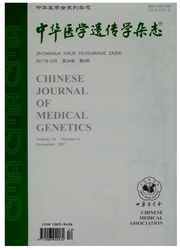

 中文摘要:
中文摘要:
目的 探讨多重荧光原位杂交(multiplex fluorescence in situ hybridization,M-FISH)技术在多发性骨髓瘤(multiple myeloma,MM)复杂核型异常(complex chromosomal aberrations,CCAs)检测中的价值.方法 对10例常规细胞遗传学(conventional cytogenetics,CC)方法检测具有复杂核型的MM患者应用M-FISH技术确定复杂染色体的重排及标记染色体的组成.结果 M-FISH证实了CC显示的29种结构异常,并进一步明确了1p-、6q-、9q-、9q+、+8q+×2、14q+、?14q、der(4)、der(22)、der(1)t(1;?)(q10;?)、der(3)、del(7)的具体来源;同时也发现CC分析没有发现或不能识别的21种异常,其中t(2;15)(q33;q22)、t(6;7)(q23;q34)、t(8;11)(q24;q23)、t(1;14)(q10;q32)和t(X;1)(q26;q25)是新发现的核型异常.这10例随访的MM患者病例资料中9例已死亡,中位生存期仅为23个月,较公认的MM患者的平均生存期34个月明显缩短.结论 对伴有CCAs的MM患者,M-FISH技术可以明确CC分析中复杂染色体异常,并发现和纠正CC分析中漏检及误检的异常,为MM的染色体异常研究提供了一种重要的方法,已经成为精确染色体核型分析所不可缺少的手段之一.
 英文摘要:
英文摘要:
Objective To explore the value of multiplex fluorescence in situ hybridization (M-FISH)in the detection of the complex chromosomal aberrations (CCAs) in multiple myeloma (MM). Methods M-FISH was used in 10 MM patients with CCAs detected by conventional cytogenetics (CC) using Rbanding to refine the rearrangement of CCAs and identify the characteristics of marker chromosome. Results M-FISH confirmed the 29 structural aberrations shown by CC analysis, and also confirmed the specific source of 21 types of chromosomal aberration, which were not detected by CC analysis. Among them, t(2;15)(q33;q22), t(6;7)(q23;q34), t(8;11) (q24;q23), t(1;14)(q10;q32) and t(X;1)(q26;q25) were new chromosomal aberrations. The median survival time of 9 MM patients with CCAs was 23 months and evidently shorter than that of MM patients without CCAs, with the mean survival time being 34 months.Conclusion M-FISH could refine CCAs in MM patients, find or correct the missed or misidentified abnormalities analyzed by CC. It has provided one of the essential methods for the research of chromosomal aberrations in MM.
 同期刊论文项目
同期刊论文项目
 同项目期刊论文
同项目期刊论文
 期刊信息
期刊信息
